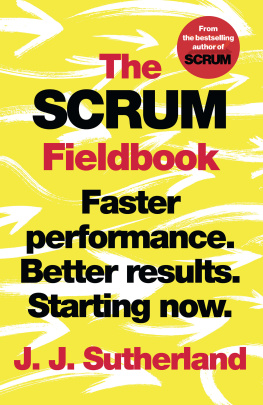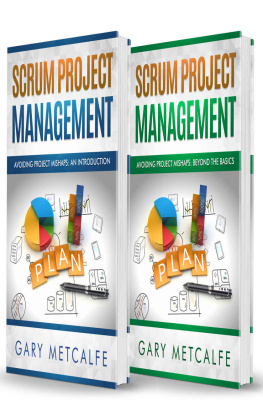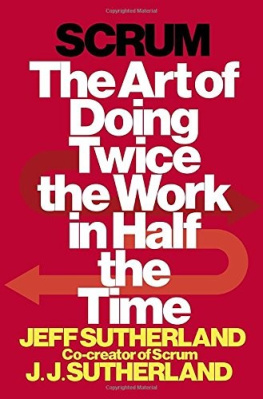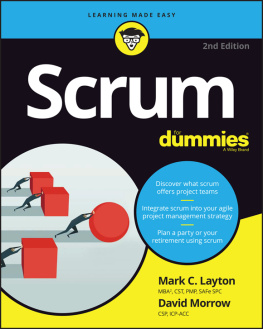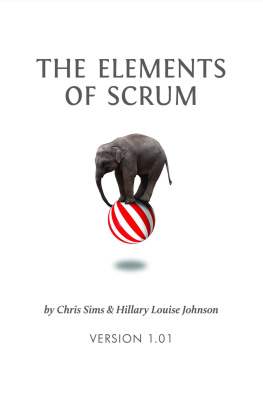
J.J. Sutherland
THE SCRUM FIELDBOOK
Faster performance. Better results. Starting now.

CONTENTS
ABOUT THE AUTHOR
J.J. Sutherland is the CEO of Scrum Inc., heading up a 30-person consulting firm to implement Scrum and Agile practices in companies and teams across the country. He is the co-author of the international bestseller Scrum: The Art of Doing Twice the Work in Half the Time, written with his father, Jeff Sutherland, the co-creator of Scrum.
Previously, he was an award-winning correspondent, producer, and Baghdad Bureau chief for NPR, covering the wars in Iraq and Afghanistan, the Arab Spring, and the earthquake and tsunami in Japan. He has won multiple Peabody, DuPont, and Edward R. Murrow awards. He lives in Washington D.C., with his family.
for v*
for insisting the books bedrock be joy
por exigir que el poste estrella del libro siempre sea esperanza
for declaring you married a writer
para enamorarte de mi otra vez
for the constant reminder to look to the light
Estoy muy bendecido y agradecido de tenerte en mi vida
This book would not be what it is without you
CHAPTER 1
The Choice Before Us
One of the most exciting things about life to me is the frequent discovery that the way I thought the world worked isnt, in fact, the way the world works. I find the revelation of just how mistaken I am to be thrilling. It implies that there is a fresher, better, more accurate, and more encompassing way of seeing the world. I have been given the gift of realizing that my old axioms, my old locked-in ways of understanding how things worked, were wrong. Usually I find that the way things work in biology, in science, in business, and in life is more intricate and involved, more subtle, and more open to change than I ever imagined. Its incredibly freeing.
It reminds me of the story behind the publication of Antoine Lavoisiers revolutionary book Trait lmentaire de chimie (Elements of Chemistry) in 1789. Lavoisier proposed that through rigorous experimentation one could derive basic principles:
It is a maxim universally admitted in geometry, and indeed in every branch of knowledge, that, in the progress of investigation, we should proceed from known facts to what is unknown.... In this manner, from a series of sensations, observations, and analyses, a successive train of ideas arises, so linked together, that an attentive observer may trace back to a certain point the order and connection of the whole sum of human knowledge.
Lavoisier theorized that there were basic chemical elements that could not be broken down. He argued that they formed the building blocks of matter. And so he rigorously began to seek them out. Hes the scientist who named oxygen, hydrogen, and carbon, the person who discovered oxygens role in combustion and respiration, who showed that water is made up of hydrogen and oxygen. He revolutionized the field of chemistry. He created a whole new language to describe how the component parts of reality interact with each other. In other words, he described anew how the world works. He was able to use the basic principles he set out to predict the existence of other elements that werent discovered in his lifetime.
Before Lavoisier, chemists could only examine those chemicals that nature just happened to have left lying around. Lavoisiers idea was that instead of just limiting ourselves to those elements, why not experiment until we can find the entire universe of all possible chemical compounds, not just those that we conveniently stumble upon?
His ideas were stunning. The publication of his book became one of the great dividing lines in the history of science. Before Lavoisier, scientists and intellectuals assumed the world worked one way. After, it was understood that the world worked completely differently. Modern chemistry was born. The world had fundamentally shifted. Today, everything from the buttons on your shirt to the chill of your refrigerator to the ink in this book or the very chips driving the device in your hands as you read these words is there only because of that discovery.
I love it when that kind of thing happens. When a new discovery fundamentally changes how we view and understand the world we live in. When everything we thought we knew is thrown into question, because of new information or new data. When the world was one way one day, and the next we have possibilities we werent even capable of conceiving the day before.
A New Way of Thinking
In the years since the publication of my first book, Scrum: The Art of Doing Twice the Work in Half the Time, co-authored with my father, Jeff Sutherland, more and more people are waking up to the fact that we are in the midst of a similar change in how the world of business works now. A revolution is driving change in the business world. And, as with Lavoisiers work, it is showing us a new world, where the old limits dont even apply. Ive been using a new phrase recently in my conversations with companies, CEOs, and senior executives: Scrum is the art of changing the possible.
The need for Scrum is being driven by rapid social, economic, and political changes, which in turn are being driven by the immense speed of technological advances. Youve no doubt heard of Moores law, coined by Gordon Moore, the co-founder of Intel. In 1965 he wrote a paper with the joyful title Cramming More Components onto Integrated Circuits. What is now called Moores law is the conclusion of the paper: the number of transistors on a chip would double every two years. Thats exponential growth. Oh, and the price of that increased computing power is cut in half at the same time.
We cannot even perceive how fast that rate of change is. It is becoming impossible to wrap your head around what will come next. Let me share an old French childrens riddle to illustrate just how fast things are taking place. Lets say you come across a beautiful lily pondmaybe the one in Giverny made so famous by Monets dozens of paintings. Picture it in your head. Still water, lilies floating on the surface, maybe a small bridge, the sky and the trees framing the pond, painting it with their reflections.
Now lets say the number of lilies in the pond doubles every day. Thirty days from now they will completely cover the surface of the water, smothering the pond with petals. The lilies, through no fault of their own, will kill all other life in the pondfish, frogs, even the lilies themselves. But there is time, isnt there, to save the pond? And after all, the lilies are lovely. If you decide to wait to intervene until the lilies cover half the pond, how many days will you have to save the pond?
One. Just one. On day twenty-nine the lilies will cover half the pond. The next day they will cover the whole thing.
Let me offer another example of the pace a doubling of transistors and power brings about. Lets use the famous example of grains of wheat on a chessboard, which dates back to 1256 (giving you some indication of how long people have been thinking about this sort of thing). If you were to place one grain of wheat on one square of a chessboard and then in each succeeding square double the number of grains of wheat, by the time you got to the last square on the board you would have doubled sixty-three times. That last square would have some 9
Next page
